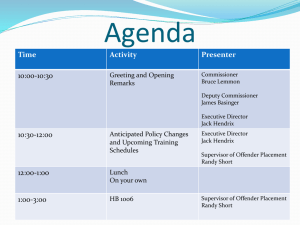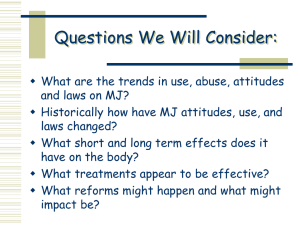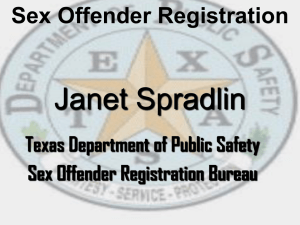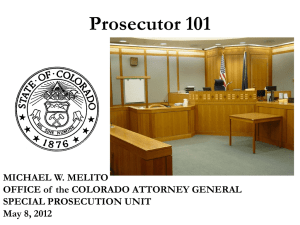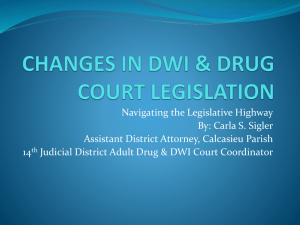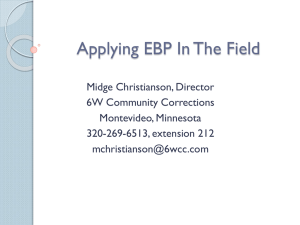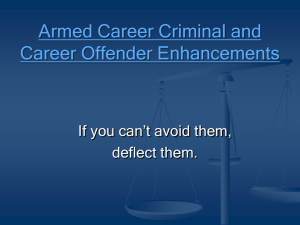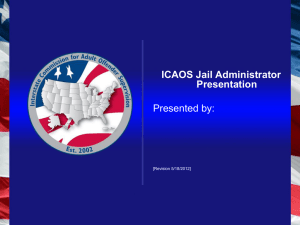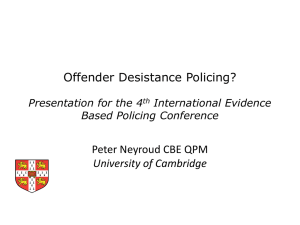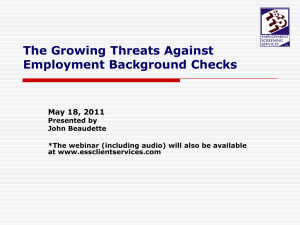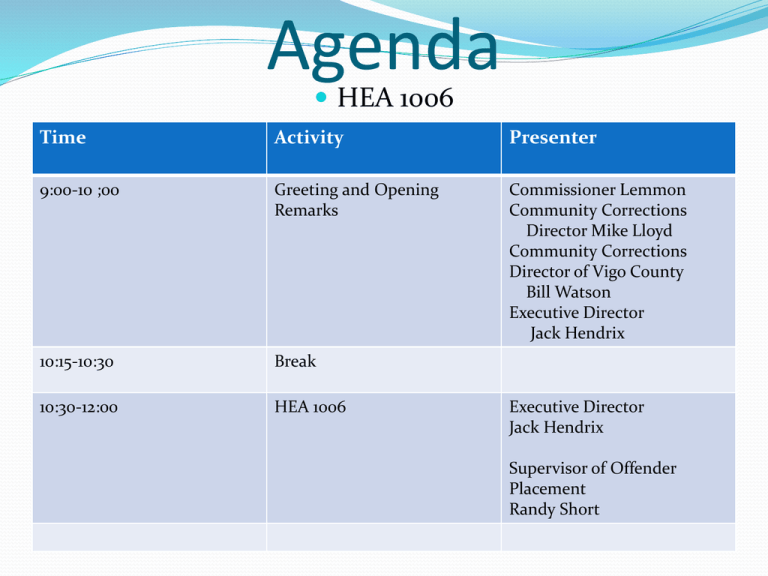
Agenda
HEA 1006
Time
Activity
Presenter
9:00-10 ;00
Greeting and Opening
Remarks
Commissioner Lemmon
Community Corrections
Director Mike Lloyd
Community Corrections
Director of Vigo County
Bill Watson
Executive Director
Jack Hendrix
10:15-10:30
Break
10:30-12:00
HEA 1006
Executive Director
Jack Hendrix
Supervisor of Offender
Placement
Randy Short
HB 1006
Upcoming
Meeting/Training Agenda
HB 1006 Kick-off Meeting
HB 1006 Regional training Sessions
Southern Region at (WVCF)
April 23, 2014 (Wednesday)
WVCF, BTC, RTC/RTI, MCU, JCU, HYC,
PD-4A, PD-4B, PD5, PD9
Central Region at (ISF)
April 30, 2014 (Wednesday)
ISF, RDC, IWP, NCF, IYC, IREF, STOP, PD1,
PD3, PD7
Northern Region at (MCF)
May 14, 2014 (Wednesday)
MCF, WCC, ISP, IR, CIF, COL, SBW, PD2,
PD6, PD8
RDC 1006 training at RDC
May 13, 2014
IDOC Case Management Retreat
CTI – May 28 & 29, 2014 (Wednesday and
Thursday)
IDOC Assistant Superintendents Retreat
CTI – August 20, 2014
CTI – November 20, 2014
IDOC Classification/Staff Development &
Training Divisions
Computer Based Training – TBA
IDOC Classification Division
Webinar Sessions – June 24-26,2014
IDOC Weekly FAQ’s
IDOC Facility Visits
Classification Analysts/Release
Specialists
Credit Time Training
CTI – September (TBA)
Training Video
OLD CODE – Prior to October 1, 1977
Indeterminate sentencing – only ones left old code
indeterminate Life sentences
1977 CODE – October 1, 1977 through June 30, 2014
Established determinate sentencing in Indiana
2014 CODE – Effective July 1, 2014
Changes how sentences are calculated and Felon
classes
FELONY OFFENSE CLASSES
1977 Criminal Code
October 1, 1977 through June 30, 2014
MURDER
Class A
Class B
Class C
Class D
Felony
Felony
Felony
Felony
2014 Criminal Code
Effective July 1, 2014
MURDER
Level 1
Level 2
Level 3
Level 4
Level 5
Class A Misdemeanor
Class B Misdemeanor
Class C Misdemeanor
Level 6
Class A
Class B
Class C
Misdemeanor
Misdemeanor
Misdemeanor
Felony Sentence Table
Type of
Conviction
Murder
Type of
Conviction
Sentence
(Years)
Mitigation
(Maximum
Reduction)
Fixed Term
(Presumptive)
Aggravation
(Maximum
Addition)
Maximum
Fine
10
55
Death
Life W/O
Parole
10
10,000
Habitual
Offender
Live W/O
Parole
1 ½ - 30
Enhancement
Class A
Class B
Class C
Class D
10,000
10
4
2
1
30
10
4
1½
20
10
4
1½
10,000
Advisory
Range
Options
Murder
55 years
45-65
Death
Life W/O
Parole
Level 1
30
20-40
Level 2
17.50
10-30
Level 3
9
3-16
Level 4
6
2-12
Level 5
3
1-6
Level 6
1
6 mo.-2.5
Class A
Misdemeanor
Maximum
1 year
Class B
Misdemeanor
Maximum
180 days
Class C
Misdemeanor
Maximum
60 days
10,000
10,000
10,000
Sex Offender
HEA 1006-2014 only address the
reduction of feet for enhancements
for drug crimes. There is still a
1000 feet restriction for sex
offender housing, it hasn't been
altered.
Credit Classes
1977 Criminal Code
2014 Criminal Code
October 1, 1977 through June 30, 2014
Effective July 1, 2014
A. Credit Class 1
1 day credit for every day served
B. Credit Class 2
1 day credit for every 2 days served
C. Credit Class 3
0 days credit for days served
D. Credit Class 4 (Credit Restricted Offenders)
1 day credit for every 6 days served
Credit Restricted Felons only
A. Credit Class A
1 day credit for every day served – same
as 1977 Credit Class 1 – Reserved for
level-6 Felonies and Misdemeanors
only
B. Credit Class B
1 day credit for every 3 days served
C. Credit Class C
1 days credit for every 6 days served
D. Credit Class D
0 days credit time earned – same as
1977 Credit Class 3
Credit Classes
Offenders convicted of Level-6 Felonies or
misdemeanors offenses begin their sentences in Credit
Class A. They may be demoted to Credit Class B,C, or
D. They may be promoted to Credit Class C, B, or A.
Offenders convicted of Level 1, 2, 3, 4, or 5 Felonies begin
their sentence in Credit Class B, may be demoted to
Credit Class C or D. They may be promoted to Credit
Class C or B. They may not be promoted to Credit
Class A.
Probation
Probation Violations which
occur After July 1, 2014 will
be calculated based on the
date of the original
criminal offense.
Credit Time
To be eligible for additional Credit
Time for completion of a program,
the program must be completed
during the current commitment
period to the Department of
Correction.
1977 Criminal Code
To be eligible for additional
Credit Time for completion of a
program the offender must be
in Credit Class 1 at the time of
program completion.
2014 Criminal Code
To be eligible for additional Credit Time for the
completion of a program, effective July 1, 2014, an
offender serving a sentence for a Level-6 felony
must be in Credit Class A at the time of program
completion.
Offender serving sentences for Level 1, 2, 3, 4, or 5
felonies must be in Credit Class B at the time of
program completion.
Earning Program Credit Time
Program Credit time
1977 Code
October 1, 1977 through June 30, 2014
Maximum amount an offender
may earn
1. 4 years or
2. 1/3 of the offender’s total
applicable credit time.
3. Program Time comes off
of the offender’s Release date
Program Credit time
◦ 2014 Code
◦ Effective July 1, 2014
Maximum amount an
offender may earn
1. 2 years or
2. 1/3 of the offender’s
total applicable credit time.
3. Program Time comes
off of the offender’s Release
date.
Earning Vocational Credit Time
Vocational/Technical
Credit time
1977 Code
October 1, 1977 through June 30, 2014
Maximum amount an
offender may earn.
6 months
Vocational/Technical
Credit time
◦ 2014 Code
◦ Effective July 1, 2014
Maximum amount an
offender may earn.
1 year
Community Transition
Court Approval Required
1977 Criminal Code
2014Criminal Code
October 1, 1977 through June 30, 2014
Effective July 1, 2014
Court Approval Required
Court Approval Required
If most severe offense is one
listed below
Murder
Class A Felony
Class B Felony
If most severe offense is one
listed below
Murder
Level 1 Felony
Level 2 Felony
Level 3 Felony
Level 4 Felony
Statute
(C) After June 30, 2014, and before July 1, 2015, a
court may not commit a person convicted of a
Level 6 felony to the department of correction if
the person’s earliest possible release date is less
than ninety-one (91) days from the date of
sentencing, unless the commitment is due to the
person violating a condition of probation, parole,
or community correction by committing a new
criminal offense.
Statute
(D) After June 30, 2015, a court may not commit a
person convicted of a Level 6 felony to the
department of correction if the person’s earliest
possible release date is less than three hundred
sixty-six (366) days from the date of sentencing,
unless the commitment is due to the person
violating a condition of probation, parole, or
community corrections by committing a new
criminal offense.
Sentencing
Calculation of the sentence of an offender for a
probation 1 court supervision violation will be
based on the date of the criminal offense.
If original offense occurred before July 1, 2014
time will be calculated under the 1977 Criminal
Code.
If original offense occurred after June 30, 2014
time will calculated under the 2014 Criminal Code
effective July 1, 2014.
Warning !!!
Which Criminal Code the offender will be
under is based on the Date offense is
committed (DATE OF OFFENSE).
1977 Code – If the offense is committed prior
to July 1, 2014
2014 Code – If the offense is committed after
June 30, 2014
Warning #2 !!!
Be aware – You will have
offenders at your facilities
who will be serving sentences
under both the 1977 Code
and 2014 Code that goes into
effect July 1, 2014.
Legislative Summary 2014
Criminal Law
S.E.A. 3, P.L. 147-2014 Judicial Officers. Makes battery a Level 6 felony if the offense is committed against judicial
officers while the officers are engaged in the judicial officers’ official duties; and a Level 5 felony if the offense results in
bodily injury to certain judicial officers. Permits judicial officers to possess and use a firearm in the same locations as law
enforcement officers.
S.E.A. 235, P.L. 158-2014 Mental Health Pilot Project. Requires community corrections programs to use evidence based
services, programs, and practices (known as EBP) that reduce the risk for recidivism. [Mirrors HEA 1268]
H.E.A. 1268, P.L. 184-2014 Probation and community corrections treatment.
Creates mental health and addiction forensic treatment services account to provide grants or vouchers for mental health
and addiction services. [NO $$$ appropriated for this account yet.]
AMENDS IC 11-13-2-1 State Aid for Probation Services. Puts in place the mechanism to award grants for EBP. [There is
NO money appropriated for this yet.] [Mirrors SEA 235]
H.E.A. 1155, P.L. 181-2014. Expungement. Effective March 26, 2014.
Reduces requirements to qualify for expungement. Person only required to prove payment of costs, fees, fines, and victim
restitution. Provides that a court must find by a preponderance of the evidence instead of by clear and convincing
evidence that all the requirements of expungement have been met to order a person's conviction records marked as
expunged.
If petition is granted, no information concerning the arrest may be placed or retained in any state central repository for
criminal history information or in any other alphabetically arranged criminal history information system maintained by a
local, regional, or statewide law enforcement agency. This does not require any change or alteration in:
(1) any internal record made by a law enforcement agency at the time of the arrest and not intended for release to the
public;
(2) the record of any court in which the criminal charges were filed; or
(3) records that relate to a diversion or deferral program.
Grants defense attorney and a probation department access to expunged records if authorized by court order. Specifies
procedure to regain right to possess a firearm by a person convicted of a misdemeanor crime of domestic violence.
Title 35 Felony Offenses
LEVEL 6 FELON PLACEMENT
HB1006
Any offender convicted of a Level 6 felony after July 1, 2014 that has 1-90 days actual days to serve must serve his time in the county
jail except for the following types of offenses:
Violation of Probation
Community Corrections Violation
Parole Violation
Any offender convicted of a Level 6 Felony that has 91 or more actual days to serve, and offenders convicted for Probation Violations,
Community Correction Violations, and Parole Violations can be sent to the Department of Correction to serve his sentence.
1.
Is the Level 6 conviction a Violation of Probation, Community Corrections Violation, or Parole Violation?
If YES, THE OFFENDER CAN BE SENT TO THE DEPARTMENT OF CORRECTION.
If NO, continue...
2.
Enter the Term of Sentence on the Abstract in days here
__________
(Subtract any suspended time and use only time to execute)
3.
Enter the Amount of Jail Time Credit granted here
__________
4.
Remaining Days to serve
(Subtract Jail Time Credit from Term of Sentence)
__________
5.
ACTUAL DAYS to execute:
(Divide the Term of the sentence by 2, then subtract the Jail time credit)
__________
6.
Placement:
_________________________________________________________________________
90 days or less to serve: COUNTY JAIL
91 days or more to serve: DEPARTMENT OF CORRECTION
*PLEASE NOTE* After June 30, 2015, the limit changes to 1 - 365 actual days to serve at county jail, and 366 or more actual days to serve can be sent
to the DOC.
Primary Contacts
Executive Director:
Jack Hendrix
317-232-2233
JDHendrix@idoc.IN.gov
Supervisor of Offender Placement
Randall Short
317-233-3533
Rshort@idoc.IN.gov

